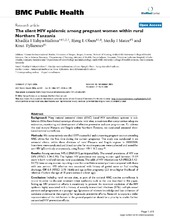| dc.description.abstract | Background: Many national antenatal clinics (ANC) based HIV surveillance systems in sub-Saharan Africa have limited coverage of remote rural sites, a weakness that compromises adequate estimation, monitoring and development of effective preventive and care programmes. To address this void in rural Manyara and Singida within Northern Tanzania, we conducted antenatal clinic-based sentinel surveillance. Methods: We consecutively enrolled 1377 counselled and consenting pregnant women attending ANC clinics for the first time during the current pregnancy. The study was conducted in six antenatal clinics, within three divisions of rural Manyara and Singida regions in 2003/2004. Interviews were conducted and blood samples for routine purposes were collected and tested for anti-HIV IgG antibody anonymously, using Bionor HIV-1 & 2 assay ®. Results: Among enrolees, 94% (1296/1377) participated fully. The overall prevalence of HIV was 2.0% (95%CI: 1.34–2.97). The highest HIV prevalence was among women aged between 15–19 years in both rural and remote rural populations. The odds of HIV infection was 4.3 (95%CI: 1.42–12.77) times among women reporting more than one lifetime sexual partners compared with those with one partner. HIV infection was associated with history of genital sores or foul smelling discharge, OR 6.8 (95%CI: 2.78–16.66) and age at first pregnancy (2.5 times higher likelihood of infection if before the age of 18 years versus at a later age). Conclusion: Including rural remote sites, as part of the national ANC routine surveillance, is crucial in order to discover imminent silent epidemics such as the one described in this paper. Scaling up HIV prevention efforts is mandatory to prevent the imminent escalation of the HIV epidemic highly associated with a history of sexually transmitted infections (STIs), multiple sexual partners and pregnancies at a younger age. Ignorance of relevant knowledge and low utilisation of condoms underscores the urgency for large-scale preventive efforts. Research to capture a wider representation of the risk factors in the general population should be a priority to enable further customised HIV prevention efforts. | en_US |
